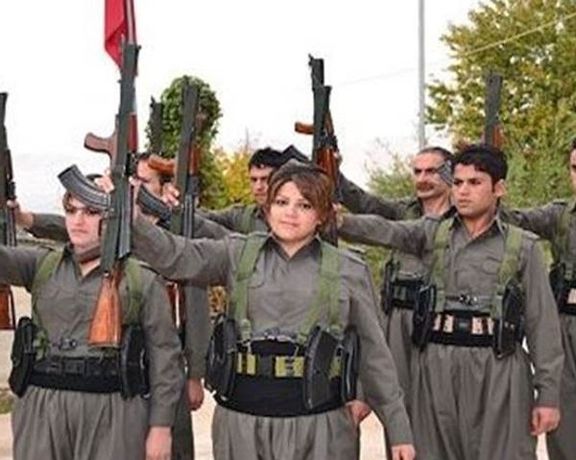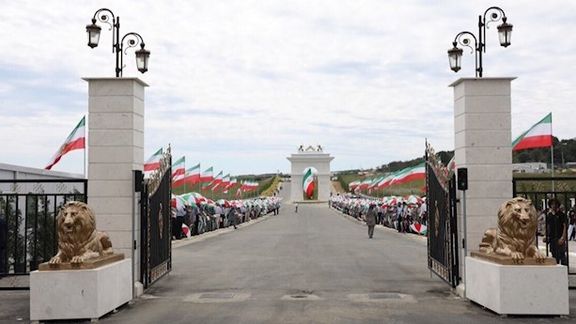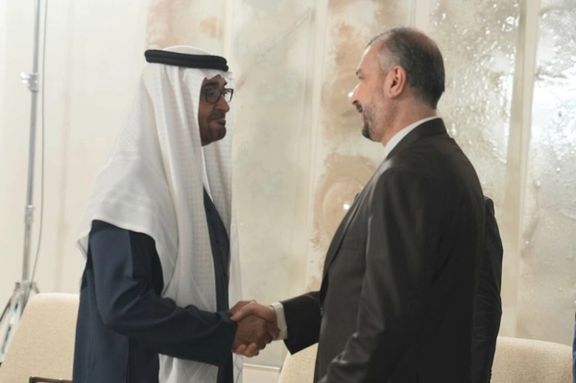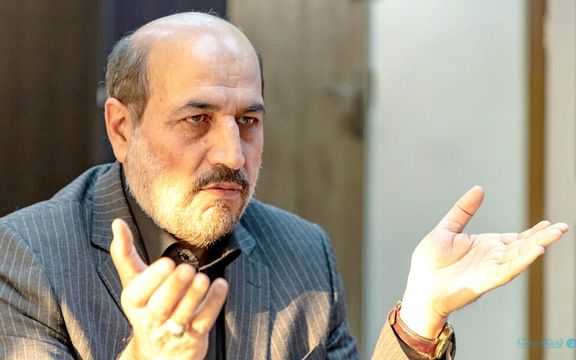Infighting Between Iranian Kurdish Groups Leaves At Least Two Dead

Clashes between two Kurdish parties in Iran left at least two dead and three wounded.

Clashes between two Kurdish parties in Iran left at least two dead and three wounded.
Following the collapse of the alliance between the Organization of the Toilers of Kurdistan and the Komala Party of Iranian Kurdistan, an armed conflict occurred between their Peshmerga forces on Thursday morning, reported Hengaw Human Rights Organization.
The Komala Party announced on Wednesday that the efforts for an alliance have failed, and they will continue their activities independently.
Sources told Iran International the security forces of the Iraqi Kurdistan region entered their camps and ended the conflict.
In a tweet, Hengaw called on the two parties to "stop the military conflict and plan for an immediate mechanism to hold negotiations and end the disputes."
The human rights organization also expressed readiness "for any mediation to resolve disputes peacefully."
Rudaw Kurdish news agency reported the conflict took place in the Zargawez in the Kurdistan region of Iraq.
The Islamic Republic had previously called for the implementation of the security agreement with Iraq to prevent the activities of Iranian Kurdish parties in the Kurdistan Region of Iraq.
Komala has been engaged in guerrilla warfare against the Iranian government, notably during the 1979 Kurdish rebellion and the Iran–Iraq War.
The Organization of the Toilers of Kurdistan, also known as the Komala Reform Faction, is an armed communist and separatist ethnic party of Kurds in Iran based in northern Iraq. It split from the Komala Party of Iranian Kurdistan in October 2007 over internal disagreements but reunited with them in November 2022.

As part of the regime’s propaganda, two busts of the former IRGC Quds Force Commander Qasem Soleimani were erected in Cuba and Nicaragua.
During the recent trip of Ebrahim Raisi to Latin America, two figurines of Soleimani were unveiled by the wife of the President of the Islamic Republic of Iran, Jamileh Alamolhoda, in the two countries, Tasnim News Agency reported Thursday.
On January 3, 2020, the US military, on the order of President Donald Trump, killed Soleimani in a drone strike near Baghdad International Airport, saying that he had been "actively developing plans to attack American diplomats and service members in Iraq and throughout the region."
One of the busts was placed in the Hall of Heroes of Nicaragua in the presence of the Ministers of Culture, Family and Science, and another one the University of Havana with the Head of the Communist Party of Cuba and the Dean of the University of Havana attending the ceremony.
“Soleimani was a man of action and a hero in the fight against terrorism for the women of the region and a harbinger of security for the whole world,” said Alamolhoda on the sidelines of the ceremony.
On Saturday, Saudi Arabia's Foreign Minister Prince Faisal bin Farhan refused to hold a joint presser in Iran under Qassem Soleimani’s picture and the presser was relocated.
The Qods Force under Soleimani became deeply involved in the conflicts in Syria and Iraq, setting up militant proxy militias.

A collective of Iranian republican opposition groups has called for a probe into the Albanian police raid on Mojahedin-e-Khalq's exile center, Camp Ashraf.
The statement from the Union for Secular Republic and Human Rights in Iran, demanded that Western countries not ignore the standards of human rights in their dealings with the Islamic Republic.
The statement came two days after opposition group Mojahedin-e-Khalq (MEK) said hundreds of Albanian police officers raided their compound known as Ashraf-3, near Manze, a small hill town some 30km west of Albania’s capital Tirana.
The opposition coalition expressed concerns about the possible cooperation of European countries with the Islamic Republic in exchange for concessions from the regime, saying that the attack on the MEK’s township is in line with Iran’s intensified efforts to stifle voices of dissent inside the country and abroad.
The group said this trend is proven by the prisoner swap between Iran and Belgium that led to the release of Iranian diplomat convicted of terrorism Assadollah Assadi in exchange for four European nationals held hostage by the regime.
“The free world cannot contribute to the spread of democracy in the world by ignoring the freedoms and rights of citizens within its own territory, even on the pretext of security concerns,” the group's statement urged, seeking the formation of a fact-finding committee to investigate the incident.

Reports about the circumstances of the incident at Camp Ashraf are full of conflicting recounts with the Albanian authorities blaming the MEK members for the clashes and the MEK accusing Albania of giving in to the whims of the Islamic Republic. Iranian Foreign Ministry Spokesperson Nasser Kanani said on Wednesday that the cult – as the regime calls the MEK -- is and will be a danger for its host country “due to its terrorist nature.”
The regime alleges that since the establishment of the Islamic Republic in 1979, the group has carried out numerous terrorist attacks against Iranian officials and civilians, killing some 17,000 people.
Also on Wednesday, Iran's vice president for legal affairs, Mohammad Dehghan, said legal measures are underway in coordination with the ministries of intelligence and foreign affairs as well as the judiciary to return “the hypocrites” to Iran. Iranian officials always refer to the exiled MEK with an Arabic term (munafiqin) that means 'hypocrites.'
“We must issue sentences for people who committed crimes against people or state property inside the country and enforce these verdicts abroad," he said.
Albania says the police were following a lead as part of an investigation over cyberattacks against the Albanian government, but the residents of the camp resisted the forces, and scuffles broke out.
The group said on Tuesday that one of their members, identified as Ali Mostashari, was killed and more than a hundred others injured, with some hospitalized in critical condition after police raided the camp using tear gas and pepper spray.
Albanian Interior Minister Bledi Cuci and the head of the national police, Muhamet Rrumbullaku, said 36 people – 15 police officers and 21 MEK members -- were injured during the raid, emphasizing that the death was not caused by any police action. Police denied any wrongdoing.
Albanian prosecutors have also charged six members of the MEK following the clashes for offenses related to the violation and destruction of police vehicles, disobeying police and court orders, as well as assault and battery of on-duty police officers. In a statement released on Thursday, the National Council of Resistance of Iran (NCRI) claimed that these six people – without identifying them – were the ones cooperating with the police and were trying to calm the situation.
Evidence revealed the MEK was informed beforehand about the police check, as was claimed by the Albanian authorities. However, according to the statement, the police showed up at the camp with 150 cars and over 1,200 forces. It added that after entering the camp, the police stationed machine guns on top of the buildings.
In a joint conference after the raid, Cuci and Rrumbullaku said that about 100 computers were seized during their searches as well as documents which, at the time of the operation, the MEK members tried to burn. The police released drone footage of MEK members moving big black bags of what they say were documents to an outdoor fireplace and trying to burn them.
Confirming some of the accounts in the NCRI statement, they said that they had a meeting with the six main leaders of the camp and were promised full cooperation. However, they said the resistance began after about two hours of search when the police found out about the MEK members' efforts not to declare server rooms and computer equipment in almost 17 facilities.
Following the incident, the US State Department released a statement, saying that it has been "assured" the Albanian government did not violate any human rights. Raising concerns about the group’s actions against its own members, including allegations of abuse, the statement emphasized that Washington does not view the MEK as “a viable democratic opposition movement that is representative of the Iranian people.”
In September 2022, Albania severed its relations with the Islamic Republic and expelled all Iranian diplomats and embassy staff following an investigation into a large-scale cyberattack that targeted the country’s infrastructure in July. The attack happened around the time of a conference held by the MEK.
The Tuesday attack against the de facto headquarters of the MEK took place about a month after the MEK-affiliated hacktivist group Uprising till Overthrow breached into 120 servers of the Iranian presidential office, getting access to internal communications, meetings minutes, and leaking troves of confidential data.

In a somewhat unexpected move, media in Tehran reported Thursday that a meeting was called between Iran's intelligence bodies, signaling possible discord.
The joint meeting of the Ministry of Intelligence and the Intelligence Organization of the IRGC was held June 16 in the religious city of Mashhad.
The session was opened with the message of the Supreme Leader Ali Khamenei who urged for more mutual understanding and synergy.
“Intelligence is one of the most important issues of the country, and one of our weaknesses in relation to intelligence systems is the lack of coordination,” read Khamenei’s message.
The meeting comes as a lack of coordination between the intelligence organizations has led to major cyber attacks from regime opposition groups. Repeated acts of sabotage attributed to Israel have also plagued the Iranian regime since July 2020.
Most recently, a hacktivist group broke into servers of the Iranian president’s office in late May and leaked troves of sensitive data, proving corruption, conflicts, and an ongoing nuclear expansion.
Intelligence Minister Esmail Khatib and the IRGC Commander Hossein Salami were among the speakers of Thursday's meeting, both underlining the necessity of better coordination.
The Secretary of the Supreme National Security Council Ali Akbar Ahmadian and the Interior Minister Ahmad Vahidi also called for a joint strategy.
It seems that there are deep rifts between the IRGC and the Ministry of Intelligence and Khamenei continues to heal the rifts but with over a dozen bodies involved in the country’s security, none of them want to lose its dominance.
However, multiple intelligence services were created during Khamenei's 34-year-old rule.

The Iranian foreign minister has invited Sheikh Mohamed bin Zayed, the president of the United Arab Emirates, to Tehran.
Hossein Amir-Abdollahian presented bin Zayed with the invitation on behalf of Iranian President Ebrahim Raisi on Thursday.
The Iranian top diplomat arrived in Abu Dhabi on the fourth and final leg of his regional tour.
Among the topics discussed were consular, cultural, economic, and political relations between Iran and the UAE.
Amir-Abdollahian visited Qatar, Oman, and Kuwait before traveling to the UAE.
Meanwhile, his deputy for political issues met with Legal Advisor to Qatari Foreign Minister, Mohammad AlKhulaifi in Doha Wednesday night.
Ali Bagheri-Kani called lasting peace and stability dependent on development and progress in the countries of the region.
“The peace and stability that does not lead to development and progress is temporary, unstable,” he noted.
Referring to the progressing relations between the two countries, AlKhulaifi said “Iran and Qatar are always partners in bringing peace and stability to the region.”
Recent restoration of diplomatic ties between Saudi Arabia and Iran signaled a new policy by the Persian Gulf Sunni Arab states for closer regional ties.
A deal brokered by China in March ended a diplomatic rift between Iran and Saudi Arabia, and re-established relations following years of hostility.
In 2016, protesters attacked the Saudi embassy in Tehran in retaliation for Riyadh's execution of a prominent Shiite cleric, which led to Riyadh severing its ties with Tehran.
The UAE and Bahrain quickly followed Saudi Arabia in severing diplomatic relations with Iran.

A member of the Iranian parliament criticized the high price of Chinese cars in the country saying Iranians pay 10 times more than its value.
Lotfollah Siahkali said: “The real price of a Chinese car is 6,000 dollars, but we sell for 60,000. Which governance rule does this follow? People are aware of the difference in car prices inside Iran and abroad. Why are we like this?"
This is not the first time the issue of importing cars or car parts from China has drawn criticism.
Last year, Mehdi Dadfar, the Secretary of the Car Importers Association, criticized the ban on car imports and market saturation by Chinese cars and parts.
“They did their best to prevent the import of famous brands and turned the country into one of the provinces of China,” he said.
It seems that China does not want to manufacture cars in Iran and prefers to export cars or parts.
For years critics and politicians have criticized the government-controlled auto industry and have referred to a “mafia” running the money-losing and inefficient sector.
Iran’s two main carmakers – Saipa and Iran Khodro – can only produce 1,400,000 units of light and heavy vehicles, mostly sub-standard older foreign models.
China has been the world’s largest car maker since 2008, with its output since 2009 higher than the US, European Union, and Japan combined. But the quality of Chinese cars is considered poor, with focus on low prices and high production numbers.